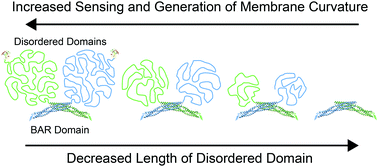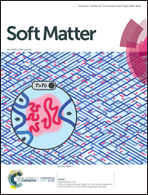Structured and intrinsically disordered domains within Amphiphysin1 work together to sense and drive membrane curvature†
Abstract
Cellular membranes undergo remodeling during many cellular processes including endocytosis, cytoskeletal protrusion, and organelle biogenesis. During these events, specialized proteins sense and amplify fluctuations in membrane curvature to create stably curved architectures. Amphiphysin1 is a multi-domain protein containing an N-terminal crescent-shaped BAR (Bin/Amphiphysin/Rvs) domain and a C-terminal domain that is largely disordered. When studied in isolation, the BAR domain of Amphiphysin1 senses membrane curvature and generates membrane tubules. However, the disordered domain has been largely overlooked in these studies. Interestingly, our recent work has demonstrated that the disordered domain is capable of substantially amplifying the membrane remodeling ability of the BAR domain. However, the physical mechanisms responsible for these effects are presently unclear. Here we elucidated the functional role of the disordered domain by gradually truncating it, creating a family of mutant proteins, each of which contained the BAR domain and a fraction of the disordered domain. Using quantitative fluorescence and electron microscopy, our results indicate that the disordered domain contributes to membrane remodeling by making it more difficult for the protein to bind to and assemble on flat membrane surfaces. Specifically, we found that the disordered domain began to significantly impact membrane remodeling when its projected area exceeded that of the BAR domain. Once this threshold was crossed, steric interactions with the membrane surface and with neighboring disordered domains gave rise to increased curvature sensing and membrane vesiculation, respectively. These findings provide insight into the synergy between structured and disordered domains, each of which play important biophysical roles in membrane remodeling.

- This article is part of the themed collection: Remodelling of Biomembranes


 Please wait while we load your content...
Please wait while we load your content...